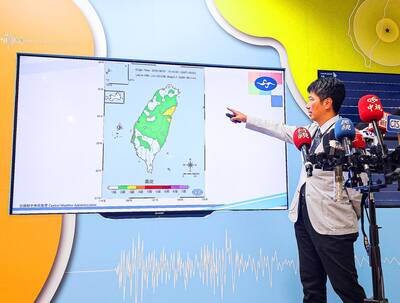The air force is to formally activate a squadron of Lockheed P-3C Orion aircraft in October after training for ground personnel is completed and the last of the 12 aircraft ordered from the US are delivered next month, a Ministry of National Defense official said yesterday.
All 12 flight crews of the marine patrol squadron have completed operational training, while the squadron’s other elements are to complete training by the end of this month, including ground control personnel, said the official, who requested anonymity.
The official rejected earlier reports citing military sources that said the squadron would be activated soon after the last aircraft’s delivery next month.

Photo courtesy of the Air Force Command Headquarters
It is more likely that the ceremony marking the squadron’s activation would take place near or during the Double Ten National Day festivities, the official said.
The air force plans to decommission its Grumman S-2 Tracker marine patrol aircraft fleet, which once totaled 27 airplanes, the official said.
The Trackers are close to being totally phased out, with several having been placed in “hot” storage — flyable condition — over the past two years, the official said.
The last Tracker in active “service” has not been flying missions and is to be decommissioned by the end of the year, the official said.
The air force received the first of its Orions in September 2013, with initial operational capability declared in July 2014, when they began operating in a mixed fleet alongside Trackers.
The replacement of Trackers with Orions began in July 2015.
In a demonstration of their operational status, the military last month released a video of Orions firing torpedoes and deploying mines during the Han Kuang military exercise.
The activation of a complete Orion squadron would upgrade anti-submarine capabilities, which military leaders have said are critical for the nation’s defense.

Aftershocks from a magnitude 6.2 earthquake that struck off Yilan County at 3:45pm yesterday could reach a magnitude of 5 to 5.5, the Central Weather Administration (CWA) said. Seismological Center technical officer Chiu Chun-ta (邱俊達) told a news conference that the epicenter of the temblor was more than 100km from Taiwan. Although predicted to measure between magnitude 5 and 5.5, the aftershocks would reach an intensity of 1 on Taiwan’s 7-tier scale, which gauges the actual effect of an earthquake, he said. The earthquake lasted longer in Taipei because the city is in a basin, he said. The quake’s epicenter was about 128.9km east-southeast

The Taipei Summer Festival is to begin tomorrow at Dadaocheng Wharf (大稻埕), featuring four themed firework shows and five live music performances throughout the month, the Taipei Department of Information and Tourism said today. The festival in the city’s Datong District (大同) is to run until Aug. 30, holding firework displays on Wednesdays and the final Saturday of the event. The first show is scheduled for tomorrow, followed by Aug. 13, 20 and 30. To celebrate the 30th anniversary of Disney Pixar's movie Toy Story, the festival has partnered with Walt Disney Co (Taiwan) to host a special themed area on

BE CAREFUL: The virus rarely causes severe illness or death, but newborns, older people and those with medical conditions are at risk of more severe illness As more than 7,000 cases of chikungunya fever have been reported in China’s Guangdong Province this year, including 2,892 new cases last week, the Centers for Disease Control (CDC) yesterday said it is monitoring the situation and considering raising the travel notice level, which might be announced today. The CDC issued a level 1 travel notice, or “watch,” for Guangdong Province on July 22, citing an outbreak in Foshan, a manufacturing hub in the south of the province, that was reported early last month. Between July 27 and Saturday, the province reported 2,892 new cases of chikungunya, reaching a total of 7,716

The New Taipei City Government today warned about the often-overlooked dangers of playing in water, and recommended safe swimming destinations to cool off from the summer heat. The following locations in the city as safe and fun for those looking to enjoy the water: Chienshuiwan (淺水灣), Baishawan (白沙灣), Jhongjiao Bay (中角灣), Fulong Beach Resort (福隆海水浴場) and Sansia District’s (三峽) Dabao River (大豹溪), New Taipei City Tourism and Travel Department Director-General Yang Tsung-min (楊宗珉) said. Outdoor bodies of water have variables outside of human control, such as changing currents, differing elevations and environmental hazards, all of which can lead to accidents, Yang said. Sudden